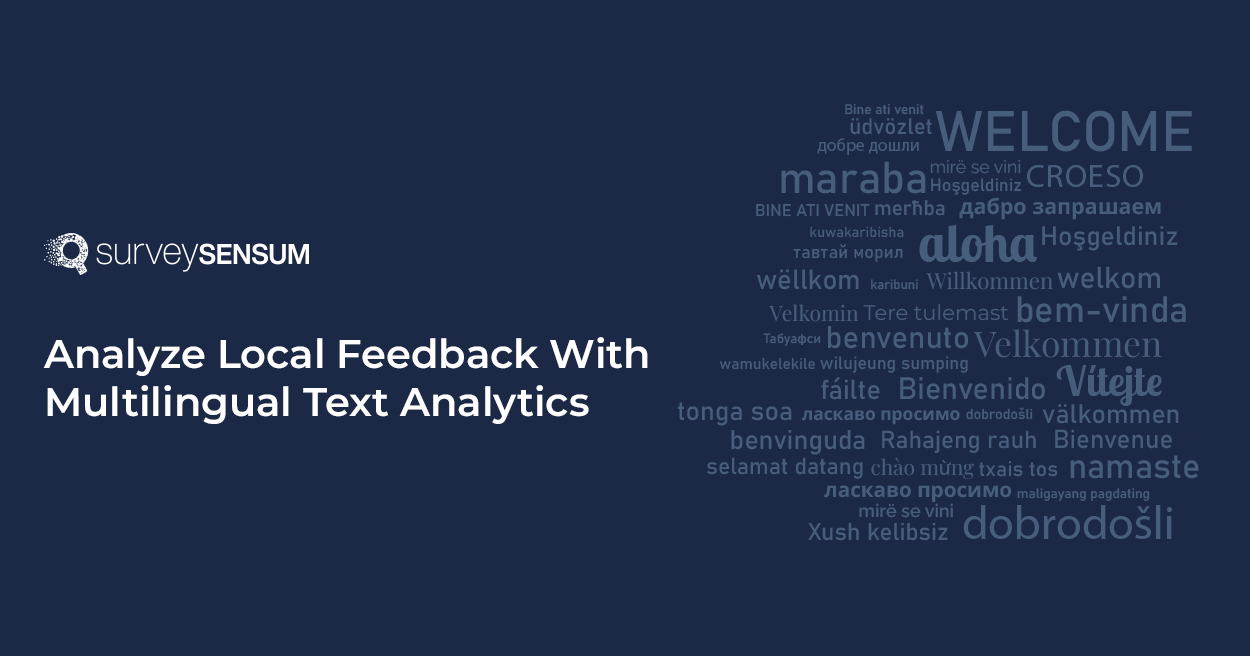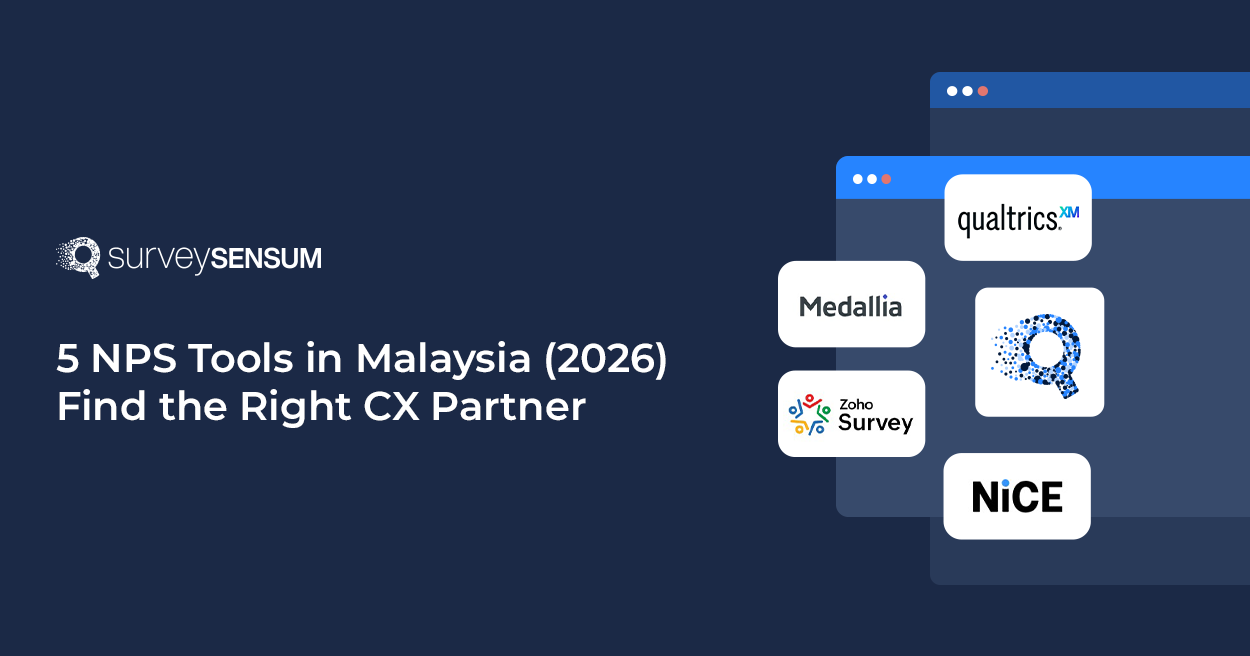

→ मैं अपने अनुभव से खुश हूं।
Imagine receiving a survey response in Hindi, now, how can you analyze feedback like this without manually going through each and every one of them?
Well, with Multilingual Text Analytics Software, you can!
Multilingual Text Analytics not only automates the process of analyzing and tagging thousands of feedback into different categories but also helps you run the analysis in your NATIVE language.
So, let’s uncover how you can use a multilingual text analysis tool to analyze feedback in any local language. But first, let’s talk a bit about what multilingual text analysis is and why it is important.
What is Multilingual Text Analytics?
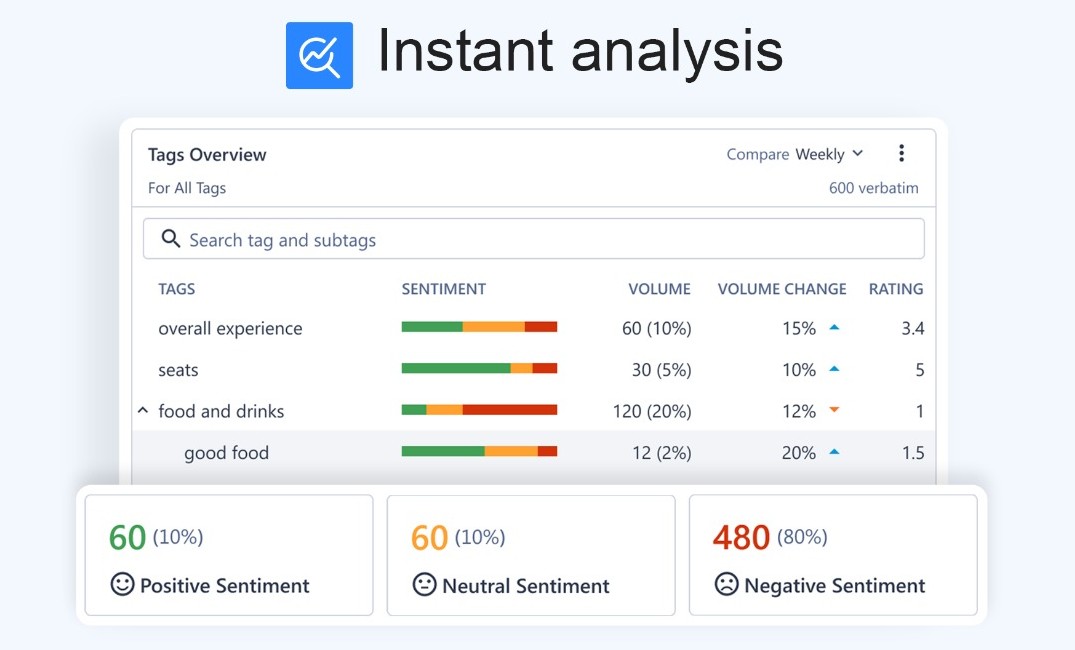
Multilingual Text Analytics is the process of analyzing text data in multiple languages using AI and NLP techniques. It helps businesses extract insights like sentiment, intent, and key themes from customer feedback, whether it’s in English, Spanish, Hindi, or any other language.
But Why is Multilingual Text Analytics?
AI-enabled text analysis is the systematic examination of open-ended responses to extract meaningful insights. Now, surely such a sophisticated process does come with a few hiccups.
One of the primary challenges of a common text and sentiment analysis is managing the linguistic diversity that encompasses varying grammatical structures, vocabularies, idiomatic expressions, and cultural nuances. These differences make it difficult to create standardized analytical models that work effectively across all languages. Additionally, ensuring the accuracy of translations and maintaining the context and sentiment of responses are significant hurdles.
Here are some more reasons why multilingual text analytics is essential for businesses today:
- Captures Global Customer Feedback: Enables businesses to analyze feedback from diverse markets – emails, reviews, chat transcripts, surveys — regardless of the language, ensuring that no insight is lost due to language barriers.
- Delivers Deeper Customer Insights: Understanding sentiment, intent, and key themes across multiple languages helps brands build a complete picture of customer experience and expectations.
- Enhances Personalization: By analyzing local language feedback, businesses can tailor experiences, products, and communication styles to resonate with each specific market.
- Boosts Customer Satisfaction and Loyalty: When customers feel heard in their native language, it fosters trust, boosts engagement, and drives long-term loyalty.
- Supports Global Growth: For businesses expanding into new regions, multilingual analytics is key to identifying cultural nuances, product reception, and market-specific challenges.
- Provides a Competitive Advantage: Companies that tap into multilingual data can make faster, more informed decisions and outperform competitors who only analyze English or localized data.
- Enables Scalable Insights with AI: With AI-powered tools, businesses can analyze vast amounts of multilingual data at scale, saving time, reducing manual work, and improving accuracy.
Now that we have discussed the what and why, let’s understand the challenges that come with it.
Challenge With Text Analytics Software
Here are some challenges faced during multilingual text analysis.
1. Accurate Language Detection
The software must accurately detect the language of the responses.
For example, a survey respondent in a bilingual country like Germany might mix English and German within the same response. Accurate language detection is critical to ensure the text is processed correctly using the appropriate linguistic models.
In such cases, accurate language detection is crucial for processing the text correctly and using the appropriate linguistic models for each language.
2. Lost in Translation
The translation between local languages and English can introduce errors, especially with idiomatic phrases and culturally specific references.
For example, translating a nuanced piece of feedback from Mandarin to English might lose specific cultural references or subtleties in sentiment.
3. Contextual Recognition and Categorization of Languages
Culturally-specific names, places, and other entities have many variations and can be context-dependent.
For example, the same name can appear in different forms in Spanish and Portuguese due to differences in script and pronunciation. The software must accurately recognize and categorize these entities despite such variations, which requires extensive, language-specific training data.
In summary, launching surveys and gathering feedback in local languages requires text analytics to handle local language detection and sentiment analysis across diverse linguistic and cultural contexts. Addressing these challenges requires advanced NLP techniques, robust multilingual datasets, and continuous improvements in machine learning models to provide accurate and meaningful insights.
Tired of language barriers holding back your customer insights? SurveySensum’s AI analyzes multilingual open-ended feedback from global customers in 100+ languages, providing actionable insights without losing context. Overcome language barriers and understand your diverse customer base!
Now that the challenges are discussed, let’s understand how multilingual text analysis works.
Step-by-Step Process of Multilingual Text Analytics
Understanding and acting on multilingual feedback requires a systematic approach. Here’s a breakdown of how businesses can carry out multilingual text analytics effectively.
1. Data Preparation and Organization
The first step is collecting and preparing text data from various sources like surveys, reviews, chat logs, and social media. This involves:
- Cleaning the data: Removing duplicates, correcting misspellings, and eliminating irrelevant content or noise (e.g., HTML tags, emojis).
- Language detection: Identifying the language of each text snippet using AI tools.
- Translation: Translating all data into a single language for consistency, or using multilingual NLP models that can process native text directly.
- Structuring the data: Organizing content into relevant categories, such as product, service, or region, to allow for granular analysis.
2. Modular Segmentation and Analysis
Once data is ready, it’s segmented to derive actionable insights. This includes:
- Segmenting by metadata: Such as geography, age group, language, product type, or channel.
- Using pivot tables and cross-tabulation: To compare sentiment, themes, or response volume across different segments and languages.
- Identifying trends and patterns: Spotting region-specific concerns or preferences that can inform product or service improvements.
3. AI and Machine Learning Applications
Advanced AI techniques play a central role in multilingual text analytics:
- Sentiment analysis: AI models detect positive, negative, or neutral sentiment in multiple languages, accounting for cultural and linguistic nuances.
- Topic and theme extraction: Machine learning identifies recurring keywords and key themes in unstructured text.
- Semantic similarity: NLP models recognize similar feedback expressed differently across languages.
- Key driver analysis: AI identifies which aspects of the customer experience (e.g., pricing, delivery, product quality) are driving satisfaction or dissatisfaction.
This process enables businesses to gain unified, actionable insights from diverse customer bases – fueling smarter decisions and stronger global engagement.
Don’t let language limit your CX strategy. Use SurveySensum to track trends and drivers across different markets and make data-driven decisions!
Want to enhance this process? Let’s integrate it with SurveySensum.
Multilingual Text Analytics With SurveySensum
Now, with the challenge of understanding the nuanced feedback in the local languages, text analytics software needs to understand, detect, and analyze complex wordings and sentiments behind local languages. In short, you need software that can read between the lines and understand the nuances and complexities of local languages.
With SurveySensum, you can do it all and more, so let’s understand the workings of this advanced text analytics software and how it can help you uncover insights in your local language.
- Step 1: Log in to SurveySensum’s survey builder.
- Step 2: Click on “Create a survey”, select the survey template, and customize the survey.
- Step 3: After you have created the survey, go to “Translation”. Here, click on “Add Language”.
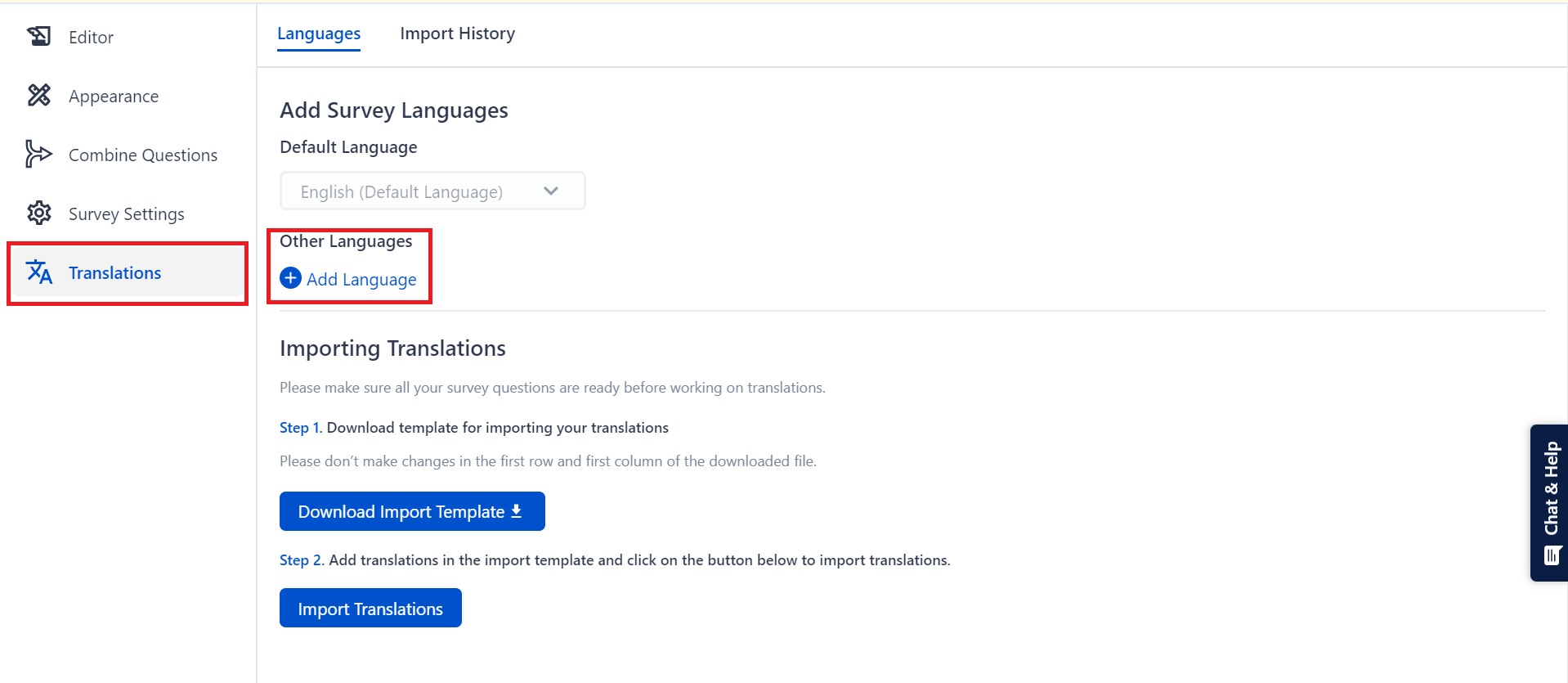
- Step 4: Here, you get the choice to translate your survey into 100+ local languages. Select the language you want to translate the survey.
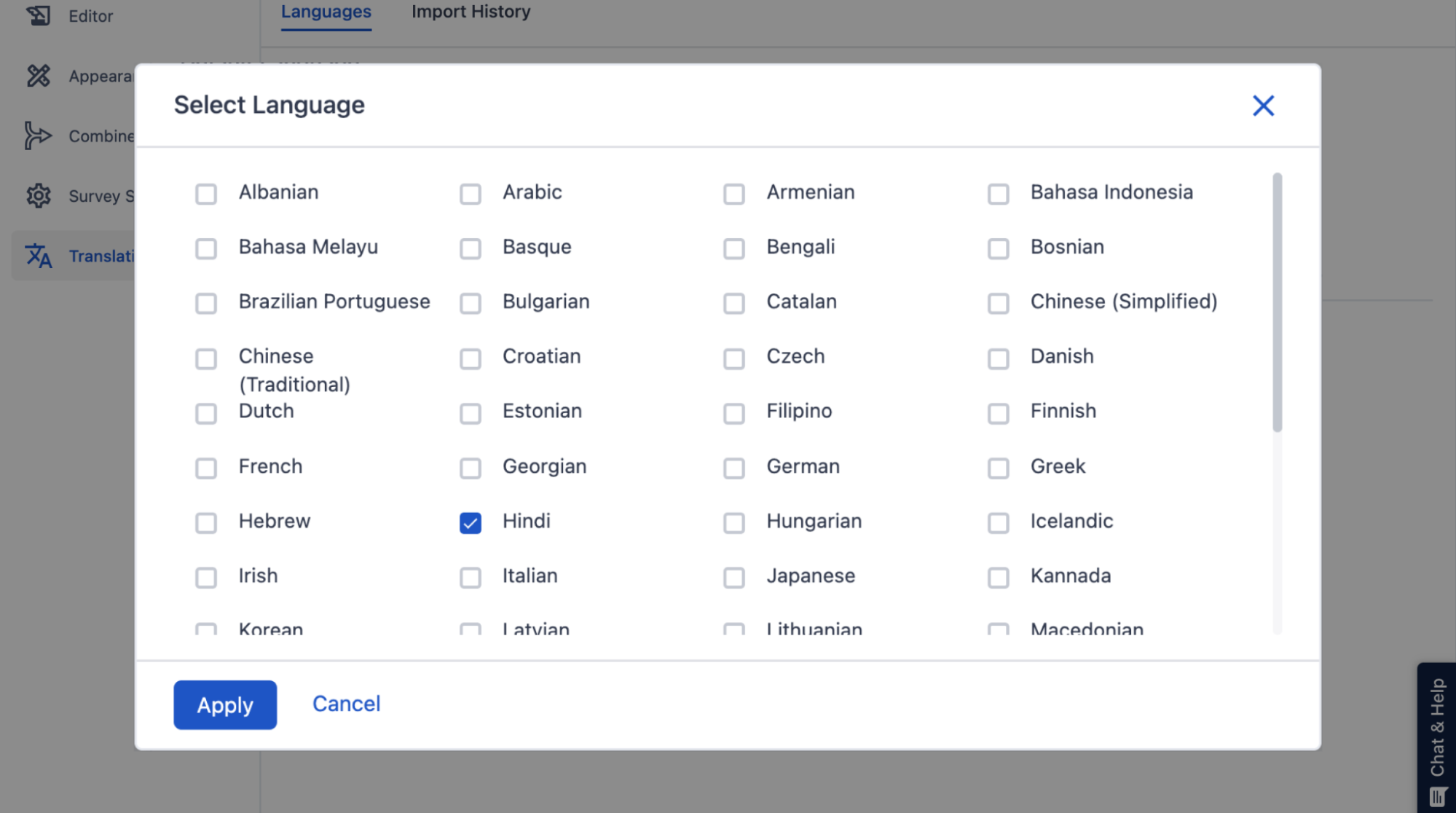
- Step 5: After you have created the survey in the local language you want, share the survey with your customers via multiple channels like SMS, email, etc.
After you have received the feedback,
- Step 1: Go to “Text Analytics”.
- Step 2: Now in the Text Analytics, train the system by reading a few comments, and figuring out some categories. For example, for a SaaS company, ‘Product Design’ can be one. Then add some keywords related to it.
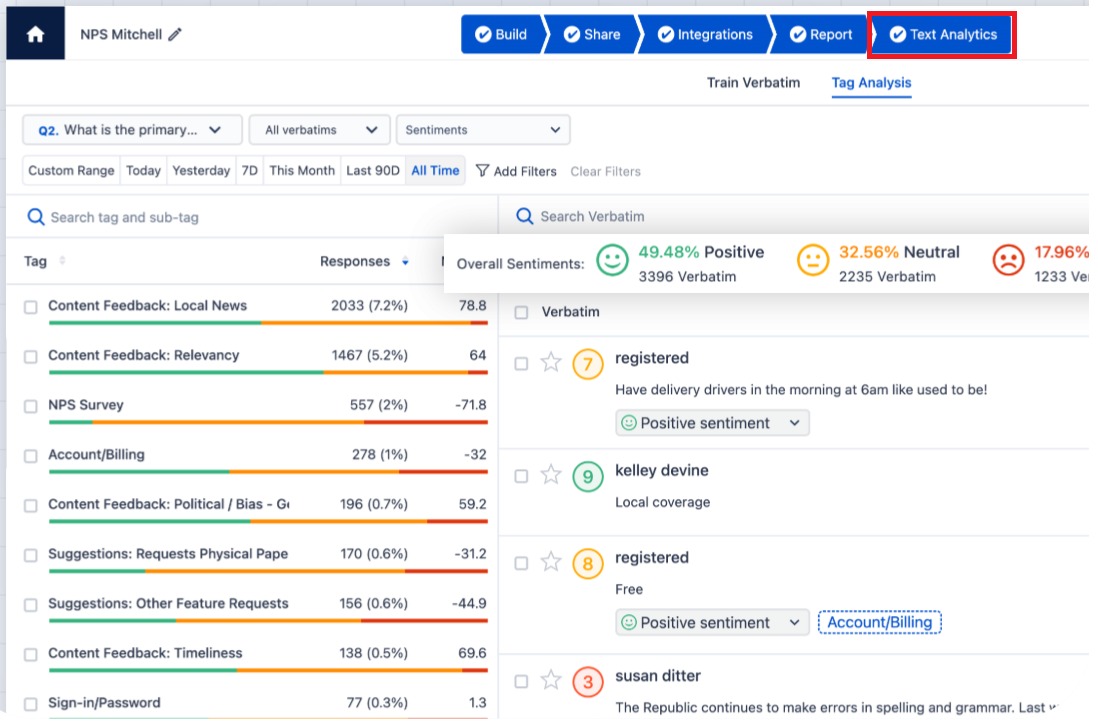
- Step 3: In tag analysis, you will see how the platform can tag every comment automatically in your local language. As you can see in the image given below, the software is correctly tagging and categorizing negative comments in Hindi and Hinglish languages under the proper category.
Conclusion
For a global and diverse audience, multilingual text analysis is a critical tool for effectively engaging and understanding this audience. The process involves overcoming significant challenges such as accurate language detection, culturally sensitive sentiment analysis, and appropriate handling of syntactic and grammatical differences across languages. The variability in linguistic resources and the need for culturally relevant interfaces further complicate the task.
To address these challenges, use AI-enabled text analytics tools like SurveySensum which uses advanced natural language processing techniques and machine learning models that are continuously getting refined and supported by extensive multilingual datasets. This tool not only enables you to correctly analyze and interpret your feedback but also enables you to read between the lines and understand the complexities and sentiments of local languages.
Frequently Asked Questions
Multilingual analysis refers to analyzing data, especially text, in multiple languages. It’s often used in global businesses to understand customer feedback, social media conversations, surveys, and reviews across different languages without needing separate models or translations for each one.
A multilingual model for sentiment analysis is an AI model that can detect emotions like positive, negative, or neutral from text written in many different languages. So, instead of building one model for English, another for Spanish, and another for French, a multilingual model handles all languages together, making it faster and more efficient for global sentiment tracking.
A multilingual NLP model is an AI model designed to perform tasks like translation, sentiment analysis, summarization, and question answering in multiple languages.
Call Center Text Analytics is the process of analyzing text-based data — like customer call transcripts, chat logs, and emails — to uncover insights about customer sentiment, behavior, and common issues. It helps call centers improve service quality, identify trends, and make data-driven decisions to enhance the customer experience.
Cross-tabulation (or crosstab) is a method used in data analysis to compare the relationship between two or more variables in a table format. It helps researchers and businesses identify patterns, correlations, and trends by showing how different groups respond differently to certain questions or situations, making it easier to spot actionable insights.
Key driver analysis is a statistical technique used to determine which factors have the biggest impact on a particular outcome, like customer satisfaction or loyalty. By identifying the “key drivers,” businesses can focus their efforts on the areas that will make the most significant difference in improving results.






